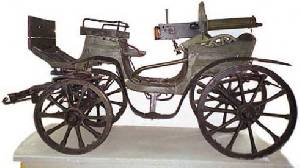
The tachanka is a horse-drawn machine gun platform, usually a cart or an open wagon with a heavy machine gun installed in the back. A tachanka can be pulled by two to four horses and requires a crew of two or three (one driver and a machine gun crew).
A regular civilian horse cart could be easily converted to military use and back. This made the tachanka very popular during the Great War on the Eastern Front, where it was used by the Russian cavalry. The use of tachankas reached its peak during the Russian Civil War (1917–1920s), particularly in the peasant regions of Southern Russia and Ukraine, where the fronts were fluid and mobile warfare gained much significance.
Tachanka tactics were centered around taking advantage of its speed to surprise the enemy. Tachankas, before the introduction of the tank or automobile to the battlefield, were the only way to provide high-speed mobility for the heavy, bulky machine guns of World War I. The speed of the horse-drawn cart would be used to move the machine gun platform to a favorable firing position, and then the enemy forces would be fired upon before they had a chance to react. Since the machine gun pointed towards the rear of the cart, the tachankas also provided effective suppressive fire onto pursuing enemy cavalry after raids and during retreats.
Originally used by Russian and Ukrainian armies, the tachanka was later adopted by a number of other countries' armies, notably the Polish Army which used it during the Polish-Soviet War. Initially mostly improvised, with time the Polish Army also adopted two models of factory-made taczankas, as they were called in Poland. They were used during the Invasion of Poland of 1939 to provide cavalry squadron support.
Despite a certain degree of standardisation, the tachanka's armament was, in most cases, improvised. In Russia, the PM M1910 machine gun was often used. The Polish cavalry of the Polish-Soviet War often used all kinds of machine guns available, including the Maxim, Schwarzlose MG M.07/12, Hotchkiss machine gun and Browning machine gun. The late models of standardised tachankas of the Polish Army were all equipped with Ckm wz.30, a Polish modification of the M1917 Browning machine gun which was also suitable for anti-air fire. The tachankas were also adopted by the Wehrmacht, which used the Jf. 5 model armed with double MG34 for anti-aircraft protection of infantry throughout World War II.